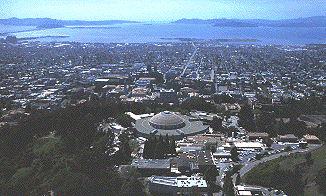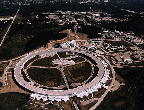
The information below was taken from the Web sites for these facilities. If you wish further information, click on a user facility name, and you will be taken directly to its Web page.
Advanced Light Source (ALS)
The ALS is a third-generation synchrotron radiation facility producing the world's brightest light in the soft x-ray and vacuum ultraviolet range of the spectrum. This electron accelerator and storage ring can generate beams of x-ray and ultraviolet light at wavelengths and energies ideal for a broad range of research -- encompassing physical, chemical, and life sciences, as well as such technological areas as materials analysis, microstructure fabrication, and macromolecular crystallography. Materials scientists can examine surface areas of only a few hundred atoms. Chemists can use the ALS facility to produce snapshot images of chemical reactions.
Biologists can use the facility to look inside living cells, while earth scientists can study environmental contaminants. The ALS is a national facility open to qualified scientists and engineers. It is located at Berkeley Lab.
 Click the image to view an ALS floor diagram.
Click the image to view an ALS floor diagram.
Advanced Photon Source (APS)
The Advanced Photon Source is a national user facility designed to produce insertion-device-based and bending-magnet-based synchrotron radiation to be used in forefront research in materials science, biology and medicine, chemistry, physics, geology, and environmental science. Advances are predicted particularly in biotechnology, polymer and advanced materials, digital imaging techniques, semiconductor materials and microelectronic circuits. The APS produces "hard" x-rays, that is, x-rays with extremely short wavelengths(4 nm to .004 nm or 4 Å to 0.4 Å). These wavelengths correspond to the energy range of the radiation produced at the APS, which is 3 keV to 300 keV. The beams from the facility are 10,000 times more brilliant than some second-generation sources. Brighter light reveals more details in structure and allows faster image-taking. Discoveries made at the APS are expected to enhance the quality of everyday living and impact the nation's economic and technological future. The facility was built by and is operated for the DOE's Office of Basic Energy Sciences, and is open to all qualified synchrotron-radiation researchers. The APS is located at Argonne National Laboratory.
 This aerial view of the APS shows the storage ring bordered by office modules for researchers. Click the image to see a larger version of the photo.
This aerial view of the APS shows the storage ring bordered by office modules for researchers. Click the image to see a larger version of the photo.

